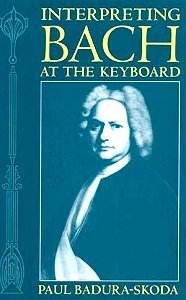Paul Badura-Skoda is a well-known pianist, fortepianist
and harpsichordist. He has recorded many discs of music by Mozart, Beethoven
and Schubert, and has also recorded Bach’s partitas. This book is a
presentation of the issues involved in performing and interpreting Bach’s
keyboard music. Badura-Skoda draws on his 40 years of experience playing
Bach, as well as a great deal of research by himself and others.
There are many issues around Bach’s keyboard music,
beginning with the age-old question of which instrument to play it on:
harpsichord or piano (or clavichord, or fortepiano, or lute-harpsichord…).
Badura-Skoda shows himself to not be a fundamentalist in this matter,
but presents both sides of the arguments about this and other performance
practice issues.
This book is essentially written for musicians or students
of Bach’s music, and examines closely such elements as tempo, articulation,
dynamics and technique, with many musical examples. The second part
of the book - more than half of it - looks at the questions of ornamentation,
certainly one of the most controversial and complex issues surrounding
baroque music.
While many chapters of this book are impervious to
those who are not performers of keyboard music, some of them are quite
accessible to the average listener. The discussion of tempo in Bach’s
music is especially enlightening, as Badura-Skoda talks about some 18th
century barrel-rolls, that give ideas of just how the music was played,
and other indications of what "authentic" tempi may be. The
chapter that discusses instruments is another accessible part of the
book, as the author gives a clear presentation of the different types
of instruments that Bach used, and how they each give different colors
to the music.
The long section on ornamentation is essentially of
interest to musicians only, but those who are seeking a comprehensive
discussion of this issue will find this book to be invaluable. Badura-Skoda
looks at each type of ornament used in Bach’s music and discusses how
they should be played.
While much of this book is for musicians, and especially
those who play keyboard instruments, non-musicians interested in Bach’s
keyboard music will find some interesting material as well. This is
a must for anyone who does play Bach’s music, and will certainly interest
other lovers of his music who want to know more about the way it is
played.
Kirk McElhearn


